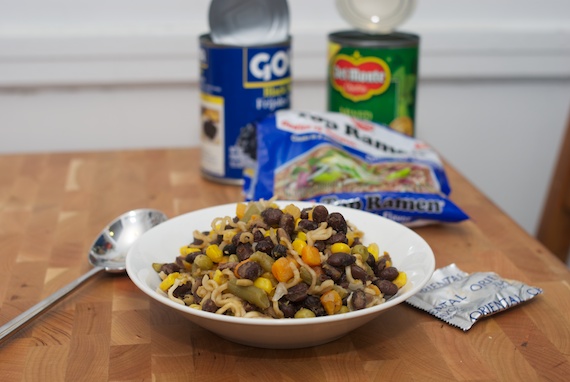
What would you do if you were hungry? For many of us, myself included, the answer is pretty straightforward – we would get something to eat. Well, first would have to figure out the details, like what we felt like eating, whether to splurge on going out or ordering in, or if we could muster the energy to prepare something at home. But for 48.8 million food insecure Americans, the hard part is figuring out where that meal will come from, and if they qualify, how they can stretch the $4 per day allotted from government benefits into a substantial satisfying meal.
Sustainable Pantry, together with over 200 food bloggers, is dedicating today’s post to raising awareness about hunger in America, and asking you to step up and help make a difference (more on that in a bit).
It’s hard to imagine what hunger in America in 2013 looks like. I know I have images ingrained in my memory from the 1980s famine in Ethiopia, and of starving, weak children with fragile, thin limbs and distended abdomens, but that’s a famine in Africa, that’s not America. How can there be 49 million hungry people in America and yet we’re the most overweight country in the world? How can 85% of families that are food insecure have at least one working adult? Why has the price of fresh produce increased by 40% during the same 30-year timeframe that the price of processed food decreased by 40%? The unfortunate reality is that although there is enough food, healthy, fresh food is not accessible to the vast majority of hungry Americans due to a tenuous web of food policy, farm subsidies, special interest groups, lobbying, and political power dynamics.
About a year ago as part of the Food Bank NY’s Food Stamp Challenge, Matthew and I subsisted on the $31/person weekly food budget allotted to participants of the Supplemental Nutrition Assistance Program (SNAP; also called food stamps) in New York City. We slowly walked through the aisles of the grocery stores adding up our pennies, we clipped coupons, we bought items on sale, and we put together a well-rounded $62 worth of groceries which included fresh vegetables, fruit, nuts, grain, beans, tofu, even Dr. Praeger’s veggie burgers. Then, I spent hours planning and preparing well-balanced meals, packing all our food for the each day out of the house, and making sure we didn’t snack when we came across food at our offices. It was totally Sustainable Pantry, but I totally missed the point of the exercise.
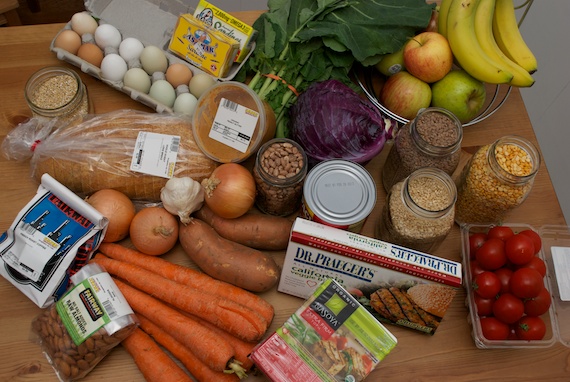
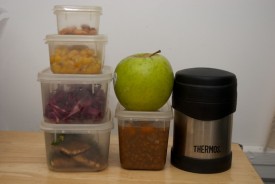

Without even realizing it, I was coming to this challenge from a place of privilege that most SNAP participants could not afford. I am privileged to have the time to slow-cook a lentil stew. I am privileged to own a slow-cooker. I am privileged to have a well-stocked refrigerator, and I am privileged to have the know-how to whip up tasty meals from dried beans and grains. Even though there were times we were hungry throughout the week, and it was definitely a challenge to work with such a paltry budget, the fact that after the week was over we would go back our relatively lavishly stocked pantry and privilege, made it impossible to feel the plight of the actual participants of the SNAP programs. We could never approximate what a food stamp recipient actually goes through, without the safety net of privilege, and a host of other challenges, such as waiting in line in a government office for hours, or forcing yourself to fall asleep to escape the unbearable hunger pangs.
These issues are all brought to the forefront in a poignant new film A Place at the Table, a documentary that profiles the struggles of three out of the 48.8 million Americans currently food insecure.
Barbie Izquierdo, a single mother of two lives in a food dessert in North Philadelphia. Barbie takes 2 busses and travels an hour each way to reach a well-stocked grocery store to buy her children fresh food. Barbie does not have the time to cook meals from scratch, even if she did have access to fresh ingredients.
Rosie, the Colorado 5th grader whose family depends on their church’s food pantry to sustain them, finds herself unable to concentrate in school, instead she finds herself daydreaming of her teacher becoming a banana and her fellow students, apples. Rosie’s mother doesn’t qualify for food assistance since she makes $120 every two weeks. That is too much income.
Tremonica, the Mississippi 2nd grader whose mother cannot afford healthy food, is obese yet she doesn’t eat breakfast because there isn’t enough food.
SNAP benefits are part of the solution for the 48.8 million Americans—including 16.2 million children—that struggle with access to nutritious food.
- An average of 40.3 million Americans used SNAP each month during 2010. (source)
- Children under 18 account for 47 percent of all food stamp recipients. Eight percent are seniors. (source)
- Forty-one percent of beneficiaries lived in households with partially- or fully-employed workers. (source)
- The average length of time a new participant stays on the [SNAP] program is 8 to 10 months. (source)
- SNAP benefits don’t last most participants the whole month. 90% of SNAP benefits are redeemed by the third week of the month. (source)
- SNAP administrative expenses are small. Federal administrative expenditures for SNAP equal less than 4.5% of overall federal SNAP costs. (source)
Despite how many people rely on this program, SNAP benefits are in jeopardy. Congress is currently working to reauthorize the Farm Bill, the legislation that provides funding for the SNAP program. Drastic cuts to SNAP are on the table. If Congress cuts funding for this program, it will impact millions of children and families, leaving them more vulnerable to hunger and starvation.
CLICK HERE to send a letter to your congressperson urging them NOT TO CUT the budget to federal food assistance programs. Make your voice heard! Cuts to these programs are short-sighted and will only lead to more children and families going hungry this year.
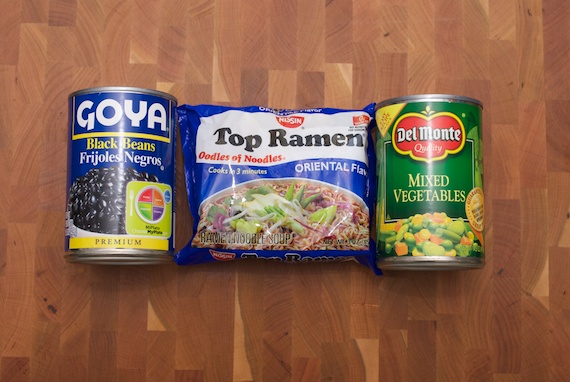
So after watching this film, and as part of the Food Bloggers against Hunger initiative, I decided to revisit the food stamp challenge, following parameters that more accurately reflect the situation of hungry Americans. Throughout the movie, the families were opening up cans and heating up food, not firing up their slow-cooker. When Rosie’s family received donations of food from the pantry, it was mostly shelf-stable and processed. Barbie spoke specifically of having to give her children a Hot Pocket for dinner. Someone else mentioned eating a meal bought at a gas station. I went to my local convenience store which does not stock fresh produce, and bought $3.88 worth of “groceries”, which is about the equivalent of what a SNAP recipient receives for ONE DAY of food. As you can see above, it got me a can of beans, a can of mixed vegetables, and a packet of ramen. I opened the cans, rinsed the contents, and sautéed the vegetables and beans together. I softened the ramen noodles in boiling water, drained them, then added them in. The meal was seasoned with the “Oriental Flavor” packet.


The meal was not nutritious. One serving contained about 90% of the recommended daily allowance for sodium (the flavor packet was pretty much straight MSG). The dish was gummy without the crunch of fresh vegetables, and although it was satisfying, I blew the daily budget on this meal that only provided 2 servings of dinner. But unlike the millions of hungry Americans, this was just an experiment, and tomorrow, I can go back to eating my fresh vegetables, taking my luxurious time to prepare healthy, local and sustainable meals. Please take a minute to help ensure that the 48.8 million Americans who rely on these programs will continue to receive the help they need.
Tell Congress: Federal nutrition programs are crucial for hungry children
Watch the movie, A Place at the Table, either in theaters or download from iTunes or Amazon.
Other Resources:
- No Kid Hungry: Share our Strength: The No Kid Hungry campaign connects kids in need with nutritious food and teaches their families how to cook healthy, affordable meals. The campaign also engages the public to make ending childhood hunger a national priority.
- New York Coalition Against Hunger: The New York City Coalition Against Hunger is the voice for the more than 1,100 nonprofit soup kitchens and food pantries in New York City and the 1.5 million low-income New Yorkers who live in homes that can’t afford enough food.
- Witnesses to Hunger: Started in Philadelphia in 2008, Witnesses to Hunger is a research and advocacy project partnering with the real experts on hunger—mothers and caregivers of young children who have experienced hunger and poverty.
- A Place at the Table: Information about the documentary by Participant Media and Take Part
- Read other bloggers’ posts about hunger awareness here.

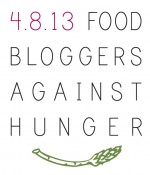
I think I’ve done everything humanly possible with ramen noodles, but this actually looks GOOD. Thanks so much for posting!
Thanks Anne! Thanks also for your post today about your personal experiences with hunger. I loved your ramen frittata recipe! Something I haven’t done with ramen, either!
Alexa-
I ventured into a similar challenge for the FBAH event and felt the same pang of privilege when plotting out my meals with my free time and well-stocked pantry. There are so many factors to food insecurity and working within a tight budget for a week only scratches the surface. I appreciate your “revisit” to the challenge. I may have to do the same.
Thanks for the comment, Keia. It does hit home realizing that even though we were trying to approximate the experience, we can never truly come close, right? Humbling. I look forward to reading about your revisit, if that happens. I learned a lot from cooking with canned vegetables – such a departure from what I am (and it sounds like you are) used to!
Great piece. The enormity of the problem can seem overwhelming. Thank you for shedding light on this.
Thanks for the support, Eldad. It is a HUGE problem, but the overwhelmed feeling I had writing it didn’t even come close to living it, so I powered on…
Wonderful post! Thanks for sharing your own experiences and putting them into the proper perspective for everyone.
Alexa,
What a terrific post! It was moving and inspiring. You have so much spot-on information that gets to the heart of the great irony of hunger in America. Just unbelievable, and yet I, too, live in blissful amnesia every day. This post will be my touchstone as I work through Slow Food (I’m a chapter leader) with my local food bank to make a difference in my community. Thank you!
Thanks Lynne and Linda, I’m glad you resonated with the post, and thank YOU for participating in the action as well!